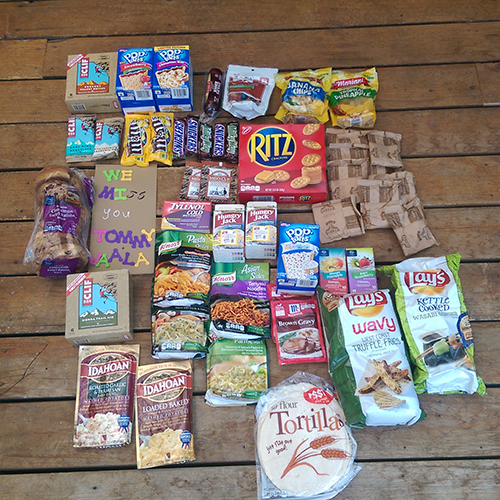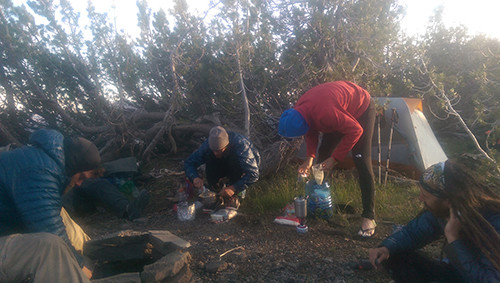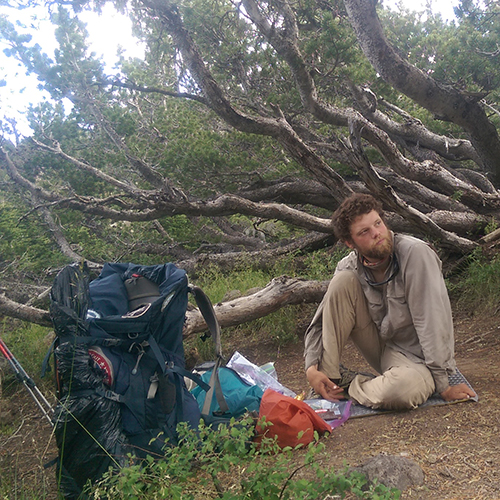
The most common questions a thru-hiker gets asked in town typically refer to our food.
“What do you eat out there?”
“How do you carry enough food for 5 months?”
“How heavy is you bag?”
“Do you mail food to yourself?”
“Do you forage for food?”
In short, we eat regular food, we only carry food for 4-5 days at a time, sometimes we mail it, and there is no foraging. But what exactly do we carry?
Most food bags weigh 8-10 lbs and consist of ~70% snacks and ~30% meals. Snacks are a huge part of a thru-hiker’s bag because constant exercise requires constant fuel. We don’t eat three square meals a day because that is simply not enough. Most hikers snack during every break and some even snack while hiking. Snacks range from protein bars, or trail mix and salami to poptarts and potato chips–anything that is easy to eat and doesn’t require cooking.
Meals range from Mountain House and Backpacker’s Pantry freeze dried meals, to Knorr sides, ramen noodles and instant mashed potatoes. Some people always have freeze dried meals and some never do. Most of us do something in between. The advantages of freeze dried are: no clean-up and a lightweight, yet filling meal. However, when you have all day to talk about food it’s easy to have a desire to get creative with your meals. Grocery store food provides this opportunity.

Resupplies are done either by mail or at grocery stores along the way. To send food by mail, hikers address a box as “General Delivery” and the post office in that town will hold it until that hiker comes to retrieve it. Sending food boxes by mail can make town chores more streamlined and overall time spent in town shorter. Because town is the most expensive part of hiking the trail, this is a great option for thrifty hikers. However, it does tend to limit the variety of food a hiker eats. For this reason, many hikers choose to resupply along the way at grocery stores when possible. This way they can pick the food they are craving that particular day or week, and not be locked-in to a menu they may have chosen months before.
For the sake of variety and affordability, Chatty Kathy and I have chosen to use food drops that friends and family have mailed to us, and supplement them in town with items that are perishable or that we may be craving. We typically add cream cheese, fresh spinach or kale, butter, eggs and a block of cheese to the box of dry food we pick up at the post office every 4-5 days. These items in particular add nutrients and fat to our diet. Fat is one of the most important aspects of our diet because it offers a high calorie to weight ratio, which means it provides more energy than other sources versus how much it weighs. Since we are carrying all of our food, weight is a significant factor in food choices. If we did not focus on adding fat to our diet we would be consuming mostly carbs and protein. Protein is good for our muscles, but carbs do not sustain us throughout the day. To feel full and still continue hiking we must be conscious of the fat content of the foods we eat. Low-fat foods are not really an option.

As far as overall caloric intake, most thru-hikers are consuming 3,500-6,000 calories per day. This is dependent on size, metabolism, gender and amount of exercise. For example, I consume about 3,700 calories per day and Chatty Kathy (who is male, 5 inches taller and 50 pounds more than me) consumes about 5,000 calories per day even though we do equal miles each day. So when we resupply for 4 days, I am usually carrying ~15,000 calories and Chatty is carrying ~20,000 calories. This is something every hiker has to figure out for themselves.
Regardless of the style of resupply a hiker chooses, planning goes a long way towards a full and happy hiker. Choosing food based on its nutritional content, weight and calories, and carrying out only the amount of food needed for that particular stretch of trail are important. If there are only 4 days before the next resupply point there is no reason to carry enough food for 6 days. However, carrying high fat and high protein foods will offer more beneficial calories than high carb foods, so a hiker would not have to carry as much. In the end, most learn through experience which style of resupply, cooking, planning and nutrition works best for them.
If you’re interested in the details of hiker nutrition, this is a useful resource:
